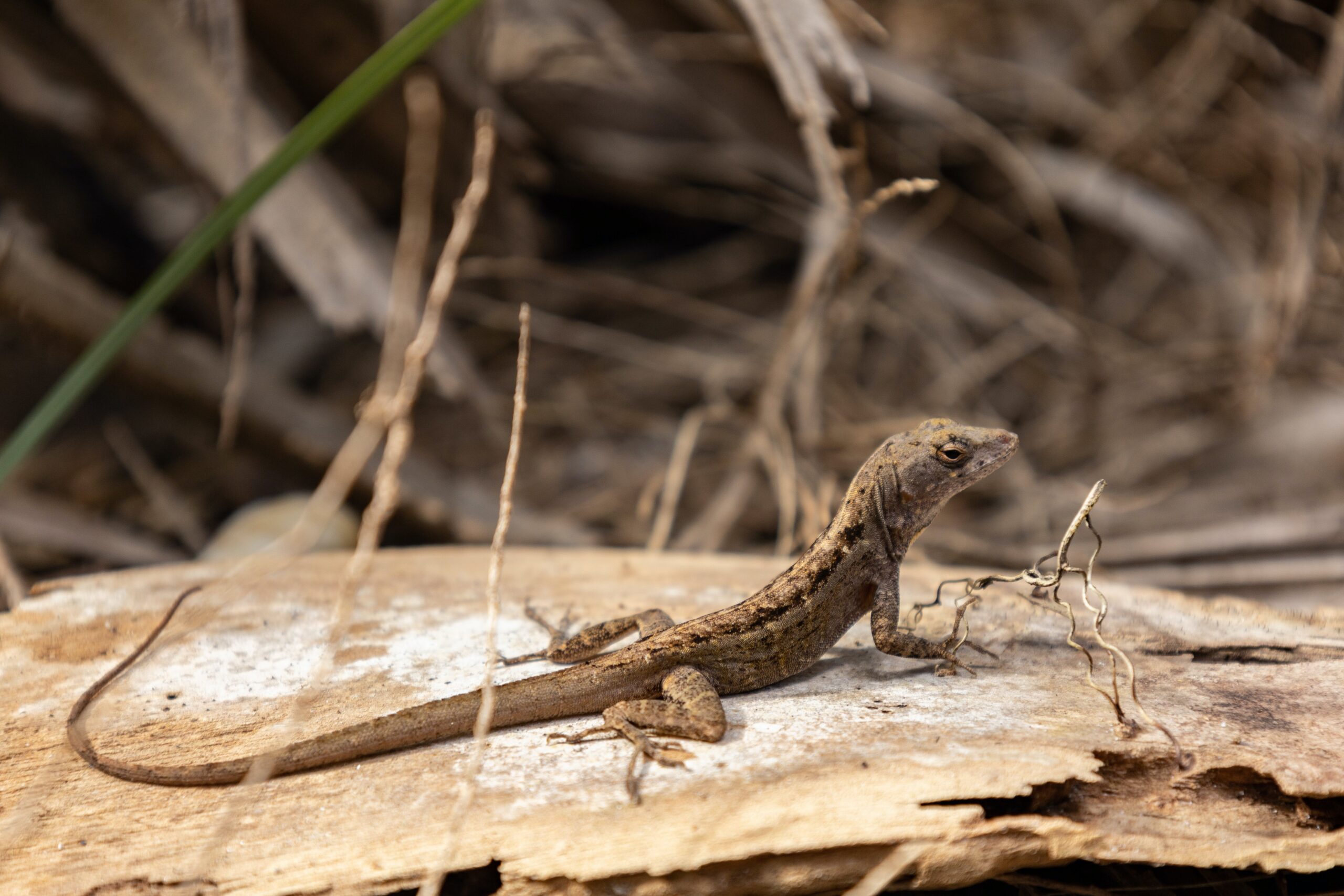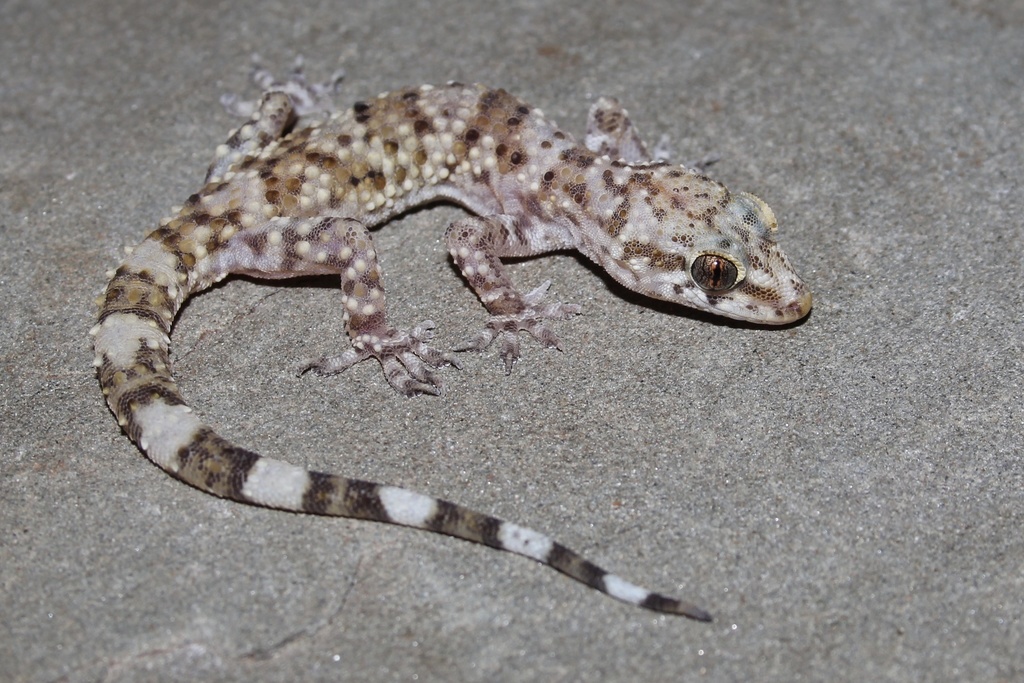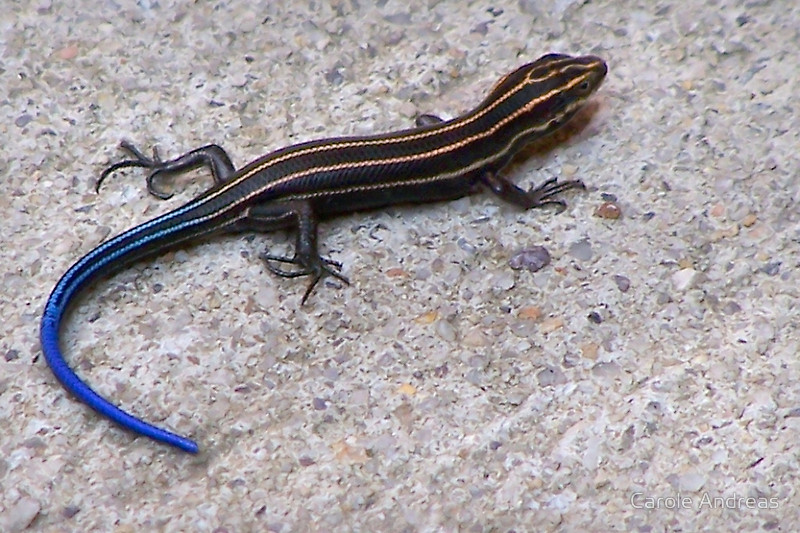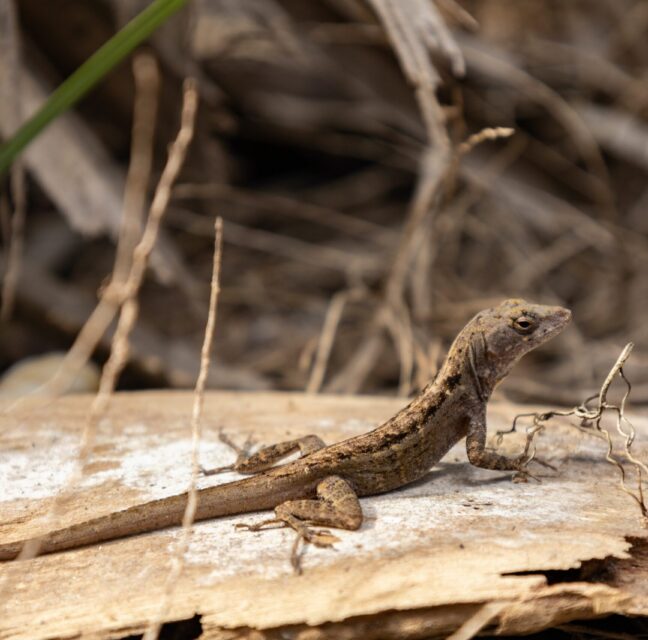
BROWN ANOLE LIZARD-SCALED
In Southwest Florida, we see these little lizards everywhere. Primarily because of the Geico commercials on TV, there is a tendency to call them all geckos, but there is a difference between anoles, geckos, and skinks.
There are basically two types of anoles – brown and green. Telling these two critters apart can be tricky. The green anole is green but can also be brown. The brown anole is brown or gray (sometimes nearly black) and never green. The green anole (the only anole native to Florida) can change color to various shades of green or brown; the brown anole can also change color but to a lesser extent. Anoles grow to a total length of 5 to 9 inches. The sexes differ in size, with mature females being slightly smaller than mature males. Their skin is relatively smooth, often with intricate patterns on their back and sides, such as stripes, triangles, spots, and dashes of lighter and darker colors. Females almost always have a light-colored stripe running down the middle of their back and tail. Crested anoles can erect a smooth-edged crest on their neck, back, and tail. Males advertise their territories and display their bright, reddish-orange throat fan (i.e. dewlap), bobbing their head, and doing push-ups. The anole’s diet consists of crickets, small locusts, mealworms, wax worms, small earthworms, small cockroaches, flies and even moths, butterflies, and spiders.
There are no known direct hazards to people caused by brown anoles, but they can be a nuisance and can be unsettling for someone who is afraid of reptiles. Once inside, they are difficult to capture because they are quick and can escape into confined spaces. Once captured, they can be handled without risk of injury to the captor, but they can deliver a noticeable bite.

The common tropical house gecko is around 3 to 5 inches long and light brown or tan with mottled grey, black, and dark brown markings from nose to tail. Their eyes are bulbous and protruding with vertical, slit-shaped pupils. As a nocturnal species, the gecko has exceptional eyesight. Thanks to its huge eyes and uniquely- shaped pupils, it can dilate to take in as much light as possible, even in nearly pitch-black conditions. House geckos are largely insectivores, but adults will consume spiders and other invertebrates, and occasionally juvenile geckos as well. They are strongly territorial and can be quite vocal at night, making a series of crisp, rapid chirps. They may make a squeaking noise when captured. Geckos are most active around sunset and sunrise when rocks and walls are warm from the heat of the sun. The skin of some geckos is covered with small tubercles that look like pimples. Geckos are very quick to autotomize, or drop off, their tails. Most species of gecko are quite shy, darting quickly for cover as soon as they see a person approaching. Most geckos do not have eyelids. Like snakes, the eyes of geckos are covered with transparent scales. The gecko keeps this transparent scale clean by wiping it with its tongue. Most geckos have extremely fine ridges and bristles on the bottom of their toes. This feature allows them to cling easily to smooth vertical surfaces, such as glass windows. Most medium-sized to large geckos are docile, but may bite if distressed, which might pierce skin.

Smooth, sleek, and shiny are the adjectives used to describe the healthy skink. All of the species of skinks found in Florida prowl on the ground for small insects, although the larger species also climb trees and wooden structures. Southeastern five-lined skinks are moderately large lizards with short legs and a streamlined body. The body is generally gray, brown, or black in background color with five white or yellowish stripes, (two on each side and one down the center of the back). Young have a bright blue tail while adult males’ stripes may fade and a reddish or orange coloration may develop on the head. Although sometimes seen in the open, these lizards are most often found beneath logs or under tree bark. When pursued, these lizards generally run for the nearest tree or log and can be quite difficult to capture. Like many other lizards, southeastern five-lined skinks will break off their tails when restrained, distracting predators and allowing the lizard to escape.

A blue tailed skink can be moderately harmful to pets. If your feline or canine friend decides to have a nibble on a blue tailed lizard, the consequences might be discomforting but usually not severe. In most cases, mild symptoms like drooling, vomiting, or diarrhea might occur as the digestive system reacts to the unusual meal. While the lizards themselves are not poisonous, the reactions they trigger in pets can still necessitate medical attention to ensure a swift recovery.
Notes: Discover Florida Nature Floridian Nature






